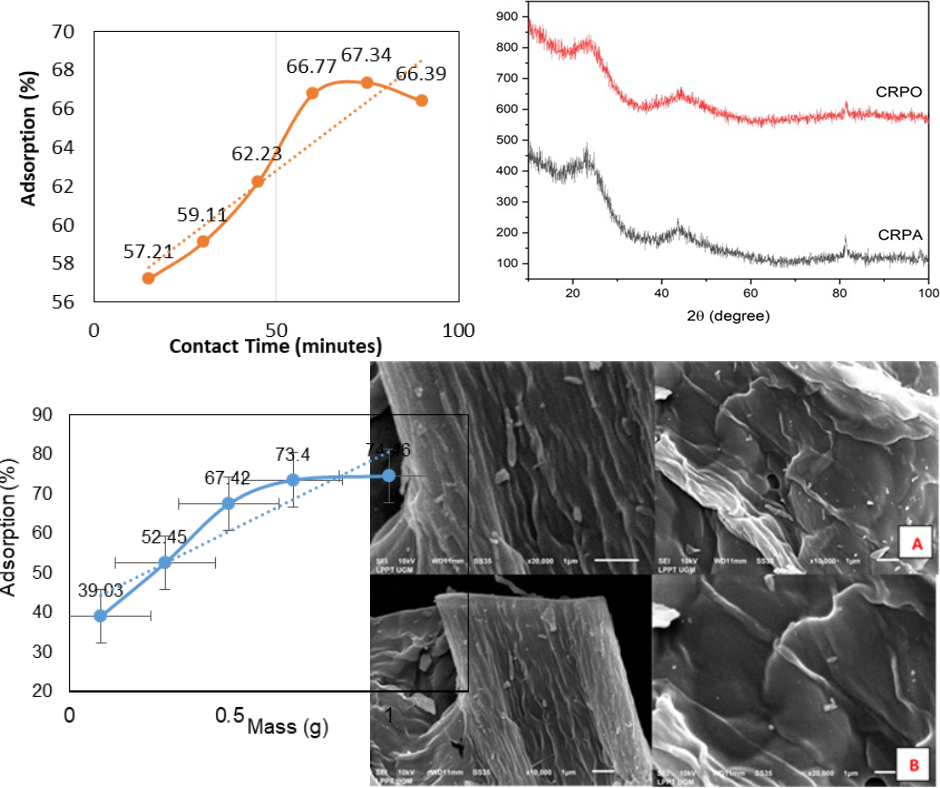Synthesis and characterization of activated carbon from biomass waste reject pulp as an adsorbent for wastewater treatment
Reject pulp
DOI:
https://doi.org/10.29303/aca.v6i2.164Keywords:
Adsorption, Carbonization, Reject Pulp, Methylene BlueAbstract
This study examines the design of a heat exchanger (HE) in the production process of nickel ferrite (NiFe2O4) nanoparticles using the coprecipitation method by determining the shell and tube heat exchanger. The Microsoft Excel application is used as a manual calculating machine to facilitate the analysis of heat exchanger (HE) data calculations. The research flowchart starts with a literature study, preparation of tools and materials for design, calculation of the main shell and tube components, and then fabrication. Based on the calculation results, the design specification data for a shell and tube heat exchanger has a shell diameter of 0.032 m, a shell length of 4.267 mm, a thickness of 0.002 m with an initial heat transfer rate (Q) of 460130 W resulting in a heat transfer efficiency of 95.706% and an NTU of 6.165. The high effectiveness value makes the design of the one shell and tube type turbulent flow heat exchanger (HE) considered to have met the standards of high effectiveness and good performance. The design and design process is complete if the device functions properly. This study can be used as a reference for researchers in designing heat exchangers during production to make them more effective, reliable, and economical.
Downloads
Metrics
References
Kunle, O. F., Egharevba, H. O., & Ahmadu, P. O. (2 1. Jasmal, Sulfikar, Ramlawati. 2015. Kapasitas Adsorpsi Arang Aktif Ijuk Pohon Aren (Arenga Pinata) Terhadap Pb2+. Jurnal Sainsmat. 4(1), 57 – 66.
Chakravarty, S., Pimple, S., Chaturvedi, H. T., Singh, S., & Gupta, K. K. (2008). Removal of copper from aqueous solution using newspaper pulp as an adsorbent. Journal of hazardous materials, 159(2-3), 396-403.
Ratna, A. S., Ghosh, A., & Mukhopadhyay, S. (2022). Advances and prospects of corn husk as a sustainable material in composites and other technical applications. Journal of cleaner production, 133563.
Van Dijk, M., & Bell, M. (2007). Rapid growth with limited learning: industrial policy and Indonesia's pulp and paper industry. Oxford Development Studies, 35(2), 149-169.
Siregar S. H, Syafri, R. Prasetya, Nasution. H., Ramadhanti, A. R. K. (2023). Pulp synthesis using bamboo raw materials through unbleached and bleached processes. Acta Chimica Asiana 6(1), pp 247-252 DOI: 10.29303/aca.v6i1.135
Aulia. A. A., Erdawati, Suhartono. 2019. Pengaruh Massa Bio-Char Kayu Akasia (acacia mangium) dan Waktu Perendaman Bio-Char Terhadap Adsorpsi Sebum Buatan. Jurnal Riset Sains dan Kimia Terapan. 8(1).
Sumathi, S., & Hung, Y. T. (2004). Treatment of pulp and paper mill wastes. In Handbook of industrial and hazardous wastes treatment (pp. 507-555). CRC Press.
Wahi, R., Abdullah, L. C., Mobarekeh, M. N., Ngaini, Z., & Yaw, T. C. S. (2017). Utilization of esterified sago bark fibre waste for removal of oil from palm oil mill effluent. Journal of environmental chemical engineering, 5(1), 170-177.
. Christy, E. O., Soemarno, S., Sumarlan, S. H., & Soehardjono, A. (2020). Pilot study on low-density binderless bark particleboards manufacture from gelam wood (Melaleuca sp.) bark. BioResources, 15(4), 7390.
Yeni. R. W., Mardhiyyatin. N., Devy. N., Abdul. A., Suparno. 2020. Penggunaan Arang Aktif Berbahan Dasr Limbah Biomassa Pada Proses Filtrasi Air Groundtank Ditinjau dari Uji TDS, Uji Kejernihan dan Uji Fe. Jurnal Teori dan Aplikasi Fisika. 8(2).
Anselmus. B, B., Hildegardis. M. 2020. Kajian Kinetika Adsorpsi Metilen Biru Menggunakan Adsorben Sabut Kelapa. 5(2), 76 – 85.
Indah. R., Nimatul. F., Suwardiyono. 2019. Adsorpsi Zat Warna Methylene Blue Menggunakan Abu Alang-Alang (Imperata cylindrica) Teraktivasi Asam Sulfat. Jurnal Teknik Kimia. 4(2), 6 – 11.
Phanthong, P., Reubroycharoen , P., Hao, X., Xu, G., Abudula, A., & Guan, G. (2018). Nanocellulose: Extraction and application. Carbon Resources Conversion 1, 32–43.
Thakur, V., Guleria, A., Kumar, S., Sharmad, S., & Singh, K. (2021 2). Recent advances in nanocellulose processing, unctionalization and applications: a review. Material Advances, 1872 - 1895.

Downloads
Published
How to Cite
Issue
Section
License
Copyright (c) 2023 Sri Hilma Siregar, Hasmalina Nasution, Wirdati Irma, Dedi Suwito, Aulia Rizki Rahmadani, Sha-Ling Han

This work is licensed under a Creative Commons Attribution-NonCommercial-ShareAlike 4.0 International License.
Authors who publish with ACA: Acta Chimica Asiana agree to the following terms:
- Authors retain copyright and grant the journal right of first publication with the work simultaneously licensed under a Creative Commons Attribution-NonCommercial-ShareAlike 4.0 International License. This license allows authors to use all articles, data sets, graphics, and appendices in data mining applications, search engines, web sites, blogs, and other platforms by providing an appropriate reference. The journal allows the author(s) to hold the copyright without restrictions and will retain publishing rights without restrictions.
- Authors are able to enter into separate, additional contractual arrangements for the non-exclusive distribution of the journal's published version of the work (e.g., post it to an institutional repository or publish it in a book), with an acknowledgement of its initial publication in ACA: Acta Chimica Asiana.
- Authors are permitted and encouraged to post their work online (e.g., in institutional repositories or on their website) prior to and during the submission process, as it can lead to productive exchanges, as well as earlier and greater citation of published work (See The Effect of Open Access).







